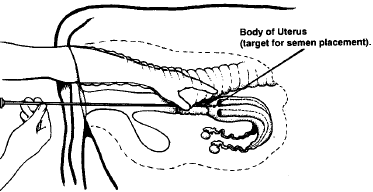The insemination process is quite straightforward. However, since relatively few sperm cells will be used, their placement is critical. The semen should be placed in the body of the uterus just in front of the cervix. You can recognize the proper site by the change in tissue consistency—from the firm and hard in the cervix to soft and spongy in the uterus. To achieve the highest possible fertility rate, semen should be deposited at the very front end of the cervix. The internal (or front) end of the cervix is often called the anterior cervical os. To deposit semen at this location requires the use of a special device called Cassou pipette, or "AI gun." The rectovaginal insemination process is used. The inseminator places his hand in the rectum and manipulates the reproductive tract so that the gun passes through the vagina, then it is manipulated through the cervical rings, and then held at the internal opening of the cervix for semen deposition. Inadequately restrained cattle will take 30 seconds to 2 minutes. At first, however, passing an insemination syringe might not be easy because you might encounter natural obstructions on your way to the target.
Beware of obstacles. The front end of the vagina forms a circular blind pouch where it joins the backward projecting cervix. This blind pouch is usually from 1.27 – 2.54cm deep, surrounding the entire dome-shaped back end of the cervix. You’ll meet other obstacles once you’re inside the cervical canal. Firm, finger-like projections arranged in three to four circular rings extend into the canal. These cause the passageway to be crooked and contain blind pockets or dead ends. The circular blind pouch of the vagina and the winding cervical canal with its dead ends are the two major stumbling blocks for anyone learning how to artificially inseminate.

Proper placement of insemination gun to deposit semen in the body of the uterus
Next to oestrus detection, semen placement error (by the technician) is most likely to affect fertility. Correct semen placement is very difficult to confirm in the field. It is impossible to check pipette placement. The pipette position changes too easily. Post-mortem tracts or examining culled cows inseminated with dye can be used to check semen placement after slaughter. Studies using dye deposition followed by slaughter have shown that up to 70 percent of the cows are inseminated incorrectly. The dye was placed in the vagina, posterior cervix, uterine horn, or bladder. The target for semen deposition is the anterior cervical os, a difficult site to find. Inexperienced inseminators often do not pass the pipette far enough, or they pass it too far into the uterine horns. Since the body of the uterus is only 1.27 – 1.91 cm in length, a pipette passage of 2.54cm into the uterus results in most of the semen entering only one horn, effectively reducing conception. Semen deposition is often made too rapidly, and semen takes the avenue of least resistance. If one horn is not as open as the other, it does not receive enough semen.
Take your time while breeding a cow and depositing the semen. It only takes a few extra seconds to make sure semen is deposited correctly. The plunger should be depressed over a 5-second period, allowing the semen to flow slowly and evenly, divided between horns. In non-pregnant cows, the walls of the uterus are soft and spongy. Inseminating syringes should never go beyond the front end of the cervix because it is too easy to poke into or through the uterine wall. This could cause infection and perhaps even fatal peritonitis.
Sanitary Technique
Wash your hands. Inseminating cows is an invasion into the delicate uterine environment that is very conducive to growing bacteria. Bacteria on your hands could be transferred to your inseminating gun during the loading procedure. If carried into the uterus during insemination, these organisms could thrive and grow rapidly resulting in metritis and infertility.
Using Technicians
Professional technicians are more successful at insemination than inexperienced owners or managers. Inseminators should periodically attend AI courses in order to improve or correct techniques. The selection of a qualified inseminator is an important element in the success of the artificial insemination program. While the insemination process is simple to understand, it does require a considerable manipulative skill. Semen-selling companies conduct three or four-day training programs, which will provide individuals with sufficient skill to begin inseminating. However, recently trained individuals generally experience lower conception rates until they have inseminated a number of animals. Regular practice at inseminating is required to maintain high conception rates. In many localities, AI studs have trained inseminators who provide insemination services for a reasonable fee. Cattle operations where artificial insemination is routinely used often have a well-trained individual who may be available as a technician. Before producers decide whether to hire a trained technician or to train a member of the farm team, they should weigh the considerable cost of a reduced conception rate during the learning process against the fees paid to a trained technician.
Click here to view a video that explains the operation process of the artificial insemination gun used by dairy cows.
Click here to view a video that explains navigating your dairy features AI techniques.